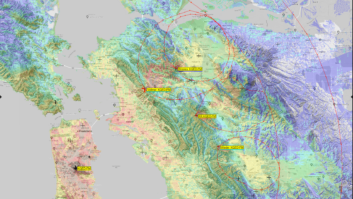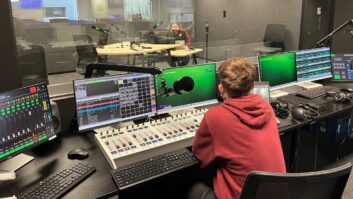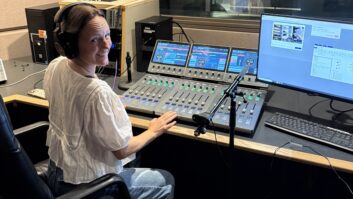It was the year 2012: Barack Obama was running for a second term in the White House; average gas prices went above $4 per gallon; the London Olympics were about to get under way. Hurricane Sandy would devastate parts of the east coast later in the year. And the San Francisco Giants would win the World Series.

Of even more significance to KQED(FM) was the order placement and subsequent delivery of a Nautel NV80 transmitter consisting of two NV40 transmitters combined with a switchless combiner. Our plan was to have the new transmitter installed in less than one year, and we thought the timeline would be easily achieved.
KQED(FM) is a 110 kW station at 88.5 MHz licensed to KQED Inc. in San Francisco. It started life as KXKX, a station run by the Presbyterian Church. It was purchased by KQED in 1969.
The programming on KQED(FM) has evolved through the years, but now consists of nearly 100 percent news and information. Programming from National Public Radio and Public Radio International is supplemented by local talk, public affairs shows and one of the largest radio news departments in the San Francisco Bay area.
If memory serves, during the 1970s, KQED had a 10 kW RCA transmitter feeding a 12-bay horizontally polarized antenna. In the 1980s, KQED(FM) changed the antenna to a six-bay circularly polarized ERI antenna and installed a Harris FM40K transmitter. (Two FM20K transmitters combined.) In 1997, KQED(FM) replaced the Harris transmitter with a pair of Continental 816Gs transmitters (rated at 22.5 kW), while retaining the combiner furnished by Harris. In 2003, KQED(FM) installed a Harris Z8HD transmitter and began broadcasting HD Radio using the auxiliary antenna for a space combined transmission system.
During the installation of the Harris Z8HD, it became clear the transmitter equipment had out-grown its space. The equipment racks were full, there was no air conditioning, and the FM combiner system and coax switches were actually located above the AC power generator, making repairs difficult and unsafe. In the summertime, the tube transmitters didn’t mind the heat, but the Harris Z8 had problems when the room temperature would climb over 100 degrees Fahrenheit. (I didn’t much like working in that heat, either.)

I became aware that a portion of one of the buildings on Mt. San Bruno was vacant, and it was about 50 percent larger than the space we had been using. It had several other advantages: It was closer to our main antenna, and it had better site lines to both our studio and the Sutro Tower, where our San Francisco television station transmits. Planning new IP microwave links would become easier suddenly. We had a very reliable 950 MHz link, and I was able to add a couple of unlicensed IP links to the studio, but the path was looking through trees that just a few years earlier were short enough not to matter.
In 2011, we contacted the landlord, American Tower, worked out a deal to move the KQED(FM) transmitter facility to the new location, and then began the actual process of planning, permitting, building and moving into the new location. We started working with architects and engineers to design a facility that would meet all of our needs at the time and, hopefully, those of the future for decades to come.
One of the first questions we addressed was whether or not we could get adequate utility power at the site. There were three existing 100 amp feeds to the room — much less than we would need. We checked with Pacific Gas & Electric Company, our local utility provider, and we were assured there would be no problem with us installing a new 800 amp service to the existing main panel board, so we proceeded with the project.

Later on, during permitting, we needed a letter from PG&E saying we could proceed; but we learned that the person who had given us the assurance was now gone and her replacement saw things differently. As one would imagine, this turned out to be a big problem and proved to be the greatest source of delay on the project.
After having redrawn our plans to include trenching for 12,000 volt lines and a pad-mount transformer and then resubmitting our plans, we finally ended with the local PG&E engineer suggesting that we just connect to the existing main panel. It really goes to show how much you are subject to the competency of your utility representatives when it comes to new facilities.
While we were in the delay period, I just described, most of the equipment for the project was ordered. Early on, we decided to go with Nautel to provide the new transmitters. Looking ahead to the possibility of higher HD power ratios in the future, we ordered a NV80 transmitter and a switchless combiner. Our FM TPO is 36.75 kW and considering the loss of efficiency in the combined amplification when adding HD Radio, two NV40s were recommended by Nautel. (Note that Nautel has since replaced its NV line of transmitters with the GV line.)
We also ordered equipment racks, an ERI coax switch and patch panel rack, interior 4-inch coax and fittings, ERI/BDI power monitoring system for the main and auxiliary antennas and 4-inch Heliax to feed to our main and auxiliary antennas. We also acquired an SAS 32KD router; a Ward-Beck systems frame to house AES DAs, A to D and D to A converters; three 2200 VA UPSs and transfer switches (I just don’t trust UPSs); a 150 kW Cummins generator and transfer switch; and an Avocent KVM system.
The transmitters, coax and equipment racks took up several parking spaces in the KQED garage for years before they were finally moved into place at the transmitter.
THE PROJECT GETS GOING
By late 2015, we had all the permits we needed to begin work. The general contractor was selected and things started happening.

In October, we began the first improvements to the space. The engineering firm decided we had to double all the ceiling joists to support the weight of the six interior fan coil units for the HVAC. Some additional demolition was needed, and the walls were sandblasted to prepare for the painting.
We hired a draftsperson to do a 3-D rendering of the project — money well spent, in my opinion. It showed us the spatial relationships between all the equipment and the HVAC plumbing, electrical conduit and lighting, RF coaxes and cable ladders. Despite being larger, our space is still relatively small, and we needed to plan the use every cubic foot of it.
Starting in February 2016, partition walls were constructed, in-wall conduit was placed, insulation for sound was added, drywall was hung and painted. By April, one new doorway and venting for the generator had been sawed into the building, and one old doorway had to be filled in with concrete block. Concrete pads were poured for the generator and the new main electrical service panel, as well as for the exterior HVAC condensers.
In May, the HVAC was installed. We have fully redundant systems, which may seem like overkill, but I am looking forward to not having to work in an 80 to 90 degree room during the summer. Having fan coils above equipment makes me nervous that a primary drain could get plugged, but we have “wet detectors” in the secondary pans connected to our Burk remote control, so we will be notified if the primary drain overflows. The secondary pans drain to the floor. The electrician also worked to get the conduit in before ceiling access would disappear due to the HVAC. This is how the 3-D model really helped the trades get their work done in the right order and without stepping on each other.

In June, the generator was delivered, and the electrician really started getting busy. Mt. San Bruno is just a few miles from the Pacific Ocean, and the salt carried onto the site is legendary. We wanted to be sure any equipment exposed to outside weather would be protected, and to that end, specified marine-grade finishing to all exterior HVAC units and stainless steel conduit, unistrut and hardware. The main 800 amp electrical feed was done in PVC coated conduit and fittings. This was a big additional expense, but there is a lot of conduit on the mountain that is rusting and needs to be replaced after only 20 years.
In July, the transmitters, combiner, RF switch rack and equipment racks were finally moved to the site. Installations began at once. By the end of the month, the new KQED electrical service panel was connected to the existing main panel. This required a power shutdown that affected one Entercom and two iHeartMedia FM stations, but all stations were covered by generators, and the engineers were most generous with their cooperation, though they requested we do the shutdown after midnight, just to be on the safe side.
By August, we were moving forward with final electrical connections to all the equipment. I didn’t want to install any broadcast equipment in the racks until the electricians were finished.
One day while I was busy bolting racks, the electricians cut some conduit over the top of one of the two transmitters, and this resulted in metal filings getting into the transmitter. (Plastic covers had unfortunately been removed.) We vacuumed out what we could, but Nautel recommended we remove each power amp and turn them upside down to shake them out. These power amps are heavy, and each transmitter has 16 amps, so the work took two of us two days to complete. We did shake and blow out enough metal filings to make the project worthwhile and a couple of the larger pieces would likely have been a guaranteed short someday.
The takeaway from this is to keep the equipment covered! The electricians were highly skilled and did a great job, but they don’t understand working around sensitive equipment.
A FURTHER DELAY BURDENS THE PROJECT

We did not want to remove the plastic covering from the transmitters and equipment racks until the HVAC was functional and fully tested in order to avoid nasty surprises like condensate raining down on our equipment.
Unfortunately, the HVAC manufacturer’s representative found several problems in its installation and gave the contractor a must-fix list; but after repeated attempts to correct the installation, the first HVAC contractor was replaced by a new one.
During this two-month process, we began installing the equipment in the building by rolling up the plastic each day, never knowing when the HVAC work would commence. We also installed unistrut and other hardware on the building exterior to facilitate the installation of the many antennas, microwave dishes and IP links we would need.
We started the installation of the interior coax, interconnecting the transmitters, combiner, reject load, dummy load and ERI coax switch and patch panel rack assembly. Nautel supplied the 3 1/8-inch rigid line to connect the transmitters to the combiner and reject load, but it was determined we would need 4-inch coax for the rest of the interior plumbing.
ERI said aluminum line would be perfect for this project, due to its lower cost and especially its reduced weight. I have never worked with the rigid aluminum line before, and I was a little apprehensive, due to my experience with aluminum Heliax in the past; but so far I have nothing but good things to say about it. We hired a tower contractor with extensive experience in radio and TV coax work, and he brought in a field engineer to ensure the installation would be electrically correct — the system would be fully swept and the matching sections on the two ERI antennas (main and aux) would be individually tuned.
Once the interior coax was substantially complete, the tower crew began work on getting the 4-inch Heliax run to the antennas. Two spools of Heliax had been stored at a local drayage company for a couple of years and because they were 12-foot diameter, I was worried that they would be hard to get to the site and then on the ground where needed.
Fortunately, the drayage company sent a very good forklift operator, and he was able to drive the spools one at a time up the gravel access road to the towers and to set them where needed. The tower crew directed the delivery, and they knew exactly how to handle this big coax. Although I didn’t do any of the actual work, I felt 20 lbs lighter at the end of the day knowing all was well with big coax and the crew handling it.

Finally, the new HVAC contractor finished its work, and the manufacturer approved it. The system was turned on and produced substantial amounts of very cold air. Normally, the AC would not chill the room to the ridiculously low temperatures, but for testing, they overrode the minimum set point, and we all put on coats, worked outside or sat next to a space heater.
Nautel wanted us to be sure to direct the chilled air to the rear of the transmitters and pull the return air from the top. To do this while keeping the ducting to a minimum, five fan coils wash the back walls with a good quantity of air, while the sixth unit cools the main building entrance area. The hot air rises and is pulled into the fan coil return input filters. This setup covers the equipment racks and transmitters quite well.
Transmitter wiring was, of course, a major part of the project. I punched a couple of holes in the transmitter to run wires directly into the control rack adjacent to the two transmitters and enlarged the wire pass through from TX-A to TX-B provided by Nautel. As much as possible, I wanted the wiring to be hidden within the transmitters and equipment rack and not brought out to the overhead cable ladder unless it was absolutely necessary.
Every wire had a wire number and a jack number making interconnecting them as easy as possible. The documentation from Nautel included wire numbers and was very easy to follow. Most of the interconnect cables are shielded CAT6 with RJ45 connectors. I personally prefer D connectors for control wiring; RJ45s just don’t feel like a 20-year connector to me, but so far every connection has worked as it should, and I have provided full strain relief and support to keep the connections working as long as the life of the transmitter.
Turning a transmitter on for the first time has always made me a bit nervous. The Nautel SC1 controller had five presets loaded at the factory. Naturally, I started with the lowest power. It came up without any problems, and I let it run for 10 minutes. The dummy load was warming up the room, so I turned the HVAC on and let the warm air and cold air mix behind the transmitter, where the dummy load lives.
Then, I tried the low power HD preset. It struggled a bit. One transmitter was happy, but the other didn’t want to come fully up. Most of the 16 power amps worked, but some of them just didn’t want to go. I turned the transmitter off and back on, and it came up without complaint.
Next was trying it at full-power 36.75 kW FM-only and 36.75 kW FM and -20 dBc HD. In FM mode, the transmitter came up without a problem, but once again the 36.75 kW FM and -20 dBc HD took a couple of tries to get it fully going. I could now do the software updates to the two transmitters. The update from 3 to 4 is a bit complicated, but by following the instructions and writing down each parameter and reading, then making the changes as required, I could then replace the compact flash cards and complete the update.
For the next several days, I operated the transmitter as much as I could to get a feel for the controls.
With the switchless combiner, I can select either transmitter or both to the load. I expect this will come in handy for updates and maintenance. Also, a couple of times, one of the transmitters would decide to shut down and the switchless combiner would then automatically feed the working transmitter to the antenna (or dummy load). After a few remote tweaks in the timing of the transmitter ramp-up by Nautel, the transmitter now starts up completely fault-free.
Finally, it was time to install the Burk remote control at the new transmitter. Much of the new broadcast equipment at the transmitter is connected to the network, so I can log into every critical piece of equipment, with the exception of our Tunwall transmitter/antenna switcher. (I do not consider this to be a negative for the Tunwall, since I fully expect it to be 100-percent reliable and to never need updating.)
We concentrated our first wiring efforts in audio, network and transmitter, and this meant the Burk and all GPI control wiring came last. It was a scramble getting it going. The Burk system had been running in test mode for years, but needed a whole new network configuration plan at the new location. The two Nautel transmitters had the Burk Plus Connect, so I could monitor and control them via SNMP. The Nautel SC1 came with a web interface, so I could log into it and control the transmitters, if necessary. Audio switching was mostly automatic using the Titus Labs 3-DRX.
FINALLY: THE CUTOVER

The tower crew assembled on a Saturday morning at the site to move the new coaxes, tune the antennas and remove the old coaxes running from the old building. Would it all go well?
Surprise — the male EIA bullets on the line sections didn’t fit to the male bullets on the 4-inch gas barriers. We decided to remove the inners from the line sections and turn them around. This worked, but left a few screw holes to be filled with nylon screws. The inner conductors were fully supported on both ends, so I don’t expect there to be any problems. This delay did mean a later start, but after lunch, it was time to disconnect the old line to the aux antenna and connect the new line in its place. The new line and the aux antenna were full swept and the VSWR showed a perfect 1 to 1.0. This antenna had been retuned by ERI when we first put HD Radio on the air, so I expected it to be good.
Now it was time to place our NV80 on the air for the first time. I have been involved in many new transmitter turn-ons before, but this was unique in my experience. I did the whole thing sitting in front of a computer. At the appropriate time I simple pressed the ON command on the Nautel SC1 controller web page and the Plate OFF command for the old transmitter on the Burk remote control web page.
No running from transmitter to transmitter. No operating coax switches or moving coax in a big hurry. No talking to a person at a remote site to coordinate OFF and ON commands. It was the simplest and least dramatic transmitter switch of my career, but it was also the most significant and satisfying.
The NV80 came up to the preset power I selected. The KQED aux antenna is lower power than the main antenna. The preset I selected was 20 kW FM and -20 dBc HD. The transmitter worked perfectly, and after checking the reflected power to be sure the load was good, I gave the go ahead to start work on the changeover for the main antenna.
Time was slipping away, and we decided to finish the change-over on Sunday. I decided to keep the NV80 on the air into the aux antenna, rather than operate the old transmitter into the main antenna overnight for two reasons:
First, I wanted to be sure the Nautel would operate hour after hour without problems. I had only run it into the dummy load for less than two hours previously, due to the heat generated. Our HVAC could keep up with it running full ON, but the air intake into Nautel TX-B was around 80 degrees.
Second, I wanted to operate the aux antenna with RF overnight, just to be sure all the connections were capable of continuous high RF for long periods of time. To say I wanted to “burn it in” is not quite what I had in mind, but you get the idea. It is likely we will not need to use it again for some time, I just wanted to know it will work when we need it. Our coverage on the aux antenna is reduced (lower HAAT), and we did get several complaints, but I’m glad we did get to test it fully.
On Sunday, the tower crew got busy with the main antenna. It was connected and swept, just as the aux antenna was; VSWR was found to be 1:1.6 and was tuned to 1:1.1. I was happy with the tuning, and we were finally ready to go in the early afternoon. After the crew had removed the old coax and the tower rigging, I simply switched the Tunwall coax switch controller to route the NV80 to the main antenna and pressed the ON command on the SC1. Just as with the aux antenna, the NV80 came up without a complaint. I selected a Nautel preset for full power and all was well — 36.75 kW FM and -20 dBc HD into a six-bay ERI antenna.
At the end of that day I was tired, but quite pleased that the last of the major parts of this four-plus-year project were complete and everything was working as expected.
In the weeks since we put the new transmitter on the air, driving tests show the HD coverage to be significantly improved, as expected. I think it sounds better, as well, and most other station personnel agree.
This was a project of the many, not the one: Also working on this project were Phil Manley, Patrick Hatten and Steve Pinch.
Larry Wood is the chief engineer of KQED(FM).







